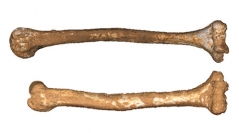

 Comptes Rendus Palevol
18 (4) - Pages 455-464
Comptes Rendus Palevol
18 (4) - Pages 455-464Cussac Cave presents a unique combination of parietal art and several hundred parts of scattered human remains, dated to the Middle Gravettian (29–28,000 cal BP). The cave is protected as a National Heritage site. As a result, only noninvasive bioanthropological analyses are allowed, consisting of in situ observations and the study of 3D models obtained by photogrammetry. Here we present the first results of these analyses of the human remains from Locus 3. Only 65 of the 106 human skeletal fragments and bones could be firmly identified. Virtual analyses were carried out on 3D models of 16 skeletal elements so that osteometric data could be provided. Despite the limitations inherent in studying commingled remains and those specific to Cussac Cave, the search for virtual pair-matching, articular congruence, and osteometric sorting allowed the allocation of twelve bones to three individuals, one late adolescent and two adults.
Upper Paleolithic, commingled human remains, photogrammetry, osteometric data, bone re-associations, pair-matching